Evaluation of Electrical Performance and Life Estimation of PPs for HVDC Power Cable
Abstract
:1. Introduction
2. Theory
2.1. Inverse Power Law
2.2. Weibull Distribution
3. Experimental
3.1. Test Sample
3.2. Experimental Setup
3.3. Test Conditions
4. Results
4.1. Ramping Test
4.2. DC V-t Test
4.3. Life Exponent and Estimation
4.4. Evaluation of Electrical Performance
5. Discussion
6. Conclusions
Author Contributions
Funding
Institutional Review Board Statement
Informed Consent Statement
Data Availability Statement
Acknowledgments
Conflicts of Interest
References
- Mazzanti, G.; Marzinotto, M. Extruded Cables for High-Voltage Direct-Current Transmission; Wlley-IEEE Press: Hoboken, NJ, USA, 2013; pp. 99–106. [Google Scholar]
- Kazuki, T.; Sukuki, H.; Hara, M.; Watanabe, K. Research and development of /spl plusmn/250 kV DC XLPE cables. IEEE Trans. Power Deliv. 1998, 13, 7–16. [Google Scholar] [CrossRef]
- Wang, H.; Cao, J.; He, Z.; Yang, J.; Han, Z.; Chen, G. Research on Overvoltage for XLPE Cable in a Modular Multilevel Converter HVDC Transmission System. IEEE Trans. Power Deliv. 2015, 31, 683–692. [Google Scholar] [CrossRef]
- Huang, X.; Fan, Y.; Zhang, J.; Jiang, P. Polypropylene based thermoplastic polymers for potential recyclable HVDC cable insulation applications. IEEE Trans. Dielectr. Electr. Insul. 2017, 24, 1446–1456. [Google Scholar] [CrossRef]
- Yoshino, K.; Ueda, A.; Demura, T.; Miyashita, Y.; Kurahashi, K.; Matsuda, Y. Property of Syndiotactic Polypropylene and Its Application to Insulation of Electric Power Cable -Property, Manufacturing and Characteristics. In Proceedings of the 7th International Conference on Properties and Applications of Dielectric Materials (ICPADM), Nagoya, Japan, 1–5 June 2003. [Google Scholar]
- Rong, X.; Shaoxin, M.; Yuli, W. Long Term Reliability Tests of 500 kV XLPE Cable System. In Proceedings of the 2014 International Conference on Power System Technology, Chengdu, China, 20–22 October 2014. [Google Scholar] [CrossRef]
- Nakiri, T.; Maekawa, Y.; Takashima, H.; Imajo, T.; Hirota, H.; Ishii, K.; Nakao, Y.; Shimada, M. Long-term reliability testing of 500 kV DC PPLP-insulated oil-filled cable and accessories. IEEE Trans. Power Deliv. 1999, 14, 319–326. [Google Scholar] [CrossRef]
- Morette, N.; Ditchi, T.; Oussar, Y. Partial Discharges Measurements and Analysis as an Evaluation Tool for the Reliability of Polymeric-Insulated Cables used under HVDC Conditions. In Proceedings of the 2018 IEEE 2nd International Conference on Dielectrics (ICD), Budapest, Hungary, 1–5 July 2018. [Google Scholar] [CrossRef]
- Wang, S.; Yu, S.; Xiang, J.; Li, J.; Li, S. DC breakdown strength of crosslinked polyethylene based nanocomposites at different temperatures. IEEE Trans. Dielectr. Electr. Insul. 2020, 27, 482–488. [Google Scholar] [CrossRef]
- Zhang, C.C.; Li, Y.F.; Hu, M.Y.; Ma, F.L.; Zhao, H.; Han, B.Z. Conductivity Properties of XLPE Insulation Used for HVDC Cable after Accelerated Thermal Ageing. In Proceedings of the 2018 12th International Conference on the Properties and Applications of Dielectric Materials (ICPADM), Xi’an, China, 20–24 May 2018. [Google Scholar]
- Dakka, M.A.; Bulinski, A.; Bamji, S. Correlation Between Space Charge Development and Breakdown in Polymeric Insulation under dc Field. In Proceedings of the 2004 IEEE International Conference on Solid Dielectrics, Toulouse, France, 5–9 July 2004. [Google Scholar]
- Li, W.; Zhang, X.; Zhao, A.; Wu, L.; Ren, Z.; Deng, J.; Zhang, G. Studies of the Polarization/Depolarization Current Characteristics of XLPE Cable. In Proceedings of the 2016 IEEE PES Asia-Pacific Power and Energy Engineering Conference (APPEEC), Xi’an, China, 25–28 October 2016. [Google Scholar]
- Shirasaka, Y.; Murase, H.; Okabe, S.; Okubo, H. Cross-sectional comparison of insulation degradation mechanisms and lifetime evaluation of power transmission equipment. IEEE Trans. Dielectr. Electr. Insul. 2009, 16, 560–573. [Google Scholar] [CrossRef]
- Yoon, J.; Kwon, J.; Ryu, J.; Bae, C.; Choi, J.; Kim, Y. A Study of Relationship between V-t and Tanδ Characteristic on Epoxy Resin. In Proceedings of the 2019 IEEE Electrical Insulation Conference (EIC), Calgary, AB, Canada, 16–19 June 2019. [Google Scholar]
- Lalam, F.B.; Djemmal, F. DC Electrical Ageing of XLPE under Hydrostatic Pressure. Adv. Mater. Sci. Eng. 2017, 2017, 3936163. [Google Scholar] [CrossRef] [Green Version]
- Murata, Y.; Sakamaki, M.; Abe, K.; Inoue, Y.; Mashio, S.; Kashiyama, S.; Matsunaga, O.; Igi, T.; Watanabe, M.; Asai, S.; et al. Development of High Voltage DC-XLPE Cable System. SEI Tech. Rev. 2013, 101, 55–62. [Google Scholar]
- Tiwana, A.P.S.; Reddy, C.C. Life Estimation of LDPE Film under Stepped-Stress Voltage Application. In Proceedings of the 2016 IEEE Conference on Electrical Insulation and Dielectric Phenomena (CEIDP), Toronto, ON, Canada, 16–19 October 2016. [Google Scholar]
- Fujimori, A.; Tanaka, T.; Takashima, H.; Imajo, T.; Hata, R.; Tanabe, T.; Yoshida, S.; Kakihana, T. Development of 500 kV DC PPLP-insulated oil-filled submarine cable. IEEE Trans. Power Deliv. 1996, 11, 43–50. [Google Scholar] [CrossRef]
- Wang, Y.; Lv, Z.; Wang, X.; Wu, K.; Zhang, C.; Li, W.; Dissado, L. Estimating the inverse power law aging exponent for the DC aging of XLPE and its nanocomposites at different temperatures. IEEE Trans. Dielectr. Electr. Insul. 2016, 23, 3504–3513. [Google Scholar] [CrossRef]
- Xia, L.; Qinxue, Y.; Minghao, L.; Kai, Z.; Lisheng, Z. Temperature Dependence of AC / DC Breakdown Strength of HVDC XLPE Cable Slices. In Proceedings of the 2016 International Conference on Condition Monitoring and Diagnosis (CMD), Xi’an, China, 25–28 September 2016. [Google Scholar]
- Hu, H.; Jia, Z.; Wang, X.; Shi, Z.; Zhang, C. Simulation of Mechanical Pressure of XLPE-SiR Interface in Cable Joints Based on Operating Temperature and Interference Parameters. In Proceedings of the 2020 IEEE International Conference on High Voltage Engineering and Application (ICHVE), Beijing, China, 6–10 September 2020. [Google Scholar]
- Brochure CIGRE 496. Recommendations for Testing DC Extruded Cable Systems for Power Transmission at a Rated Voltage up to 500 kV; CIGRE Working Group B1.32; CIGRE: Paris, France, 2012. [Google Scholar]
- Feilat, E.A.; Grzybowski, S.; Knight, P.J. Electrical Aging Models For Fine Gauge Magnet Wire Enamel of Flyback Transformer. In Proceedings of the IEEE SoutheastCon 2000, ‘Preparing for The New Millennium’ (Cat. No. 00CH37105), Nashville, TN, USA, 9 April 2000. [Google Scholar]
- Matsumoto, S.; Sato, T.; Honda, H.; Yokoyama, S. Approximate Formula for Surface V-t Characteristics of 6.6-kV Distribution Insulator. In Proceedings of the 2012 International Conference on Lightning Protection (ICLP), Vienna, Austria, 2–7 September 2012. [Google Scholar]
- Ying, L.; Hui, B.; Yu, S.; Xiaolong, C. The Measurement of Voltage Endurance Coefficient by Electrical Treeing Test for XLPE Cable Insulation. In Proceedings of the 2013 IEEE International Conference on Solid Dielectrics (ICSD), Bologna, Italy, 30 June–4 July 2013. [Google Scholar]
- Su, P.; Yin, Y.; Zheng, X.; Xuan, Y.; Wu, J. Investigation of the Thickness Effect on DC Breakdown Strength for HVDC Flexible Cable Insulation Associated with Space Charge. In Proceedings of the 2019 IEEE Electrical Insulation Conference (EIC), Calgary, AB, Canada, 16–19 June 2019. [Google Scholar]
- Yuan, W.; Wang, T.; Ni, H.; Gao, M.; Ding, Y.; Li, Y.; Zhao, Y.; Zhang, Q. Weibull Statistical Analysis of Size Effects on the Impulse Breakdown Strength in Transformer Oil. In Proceedings of the 2017 IEEE 19th International Conference on Dielectric Liquids (ICDL), Manchester, UK, 25–29 June 2017. [Google Scholar]
- Zhang, L.; Zhou, Y.; Cui, X.; Sha, Y.; Le, T.H.; Ye, Q.; Tian, J. Effect of nanoparticle surface modification on breakdown and space charge behavior of XLPE/SiO2 nanocomposites. IEEE Trans. Dielectr. Electr. Insul. 2014, 21, 1554–1564. [Google Scholar] [CrossRef]
- IEC 62431-1. Electric Strength of Insulating Materials—Test Methods—Part 1: Tests at Power Frequencies. 2013. Available online: https://webstore.iec.ch/publication/1101 (accessed on 6 September 2021).
- Kwon, J.-M.; Kwon, B.-K. High Step-Up Active-Clamp Converter with Input-Current Doubler and Out-put-Voltage Doubler for Fuel Cell Power Systems. IEEE Trans. Power Electron. 2009, 24, 108–115. [Google Scholar] [CrossRef]


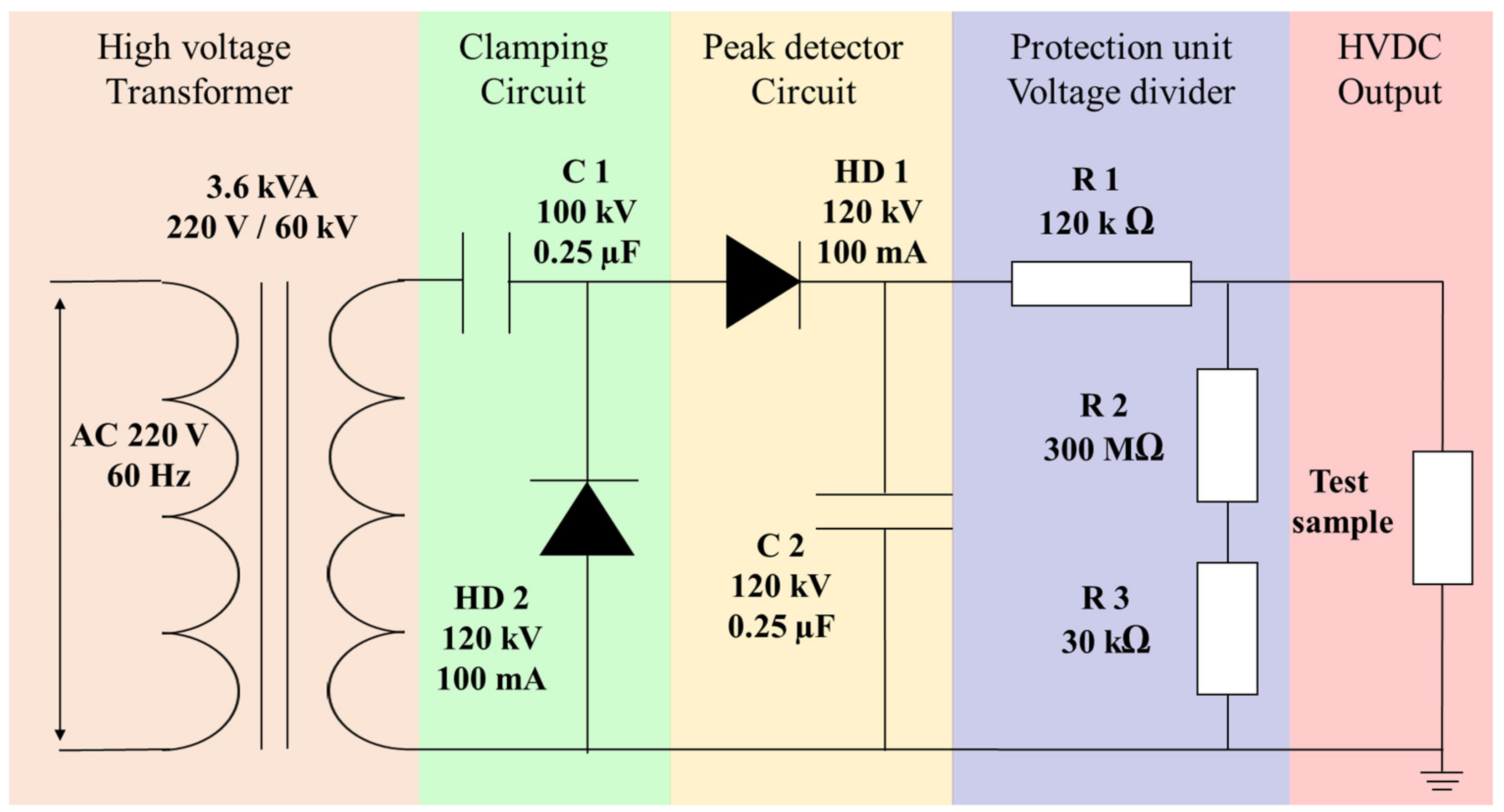


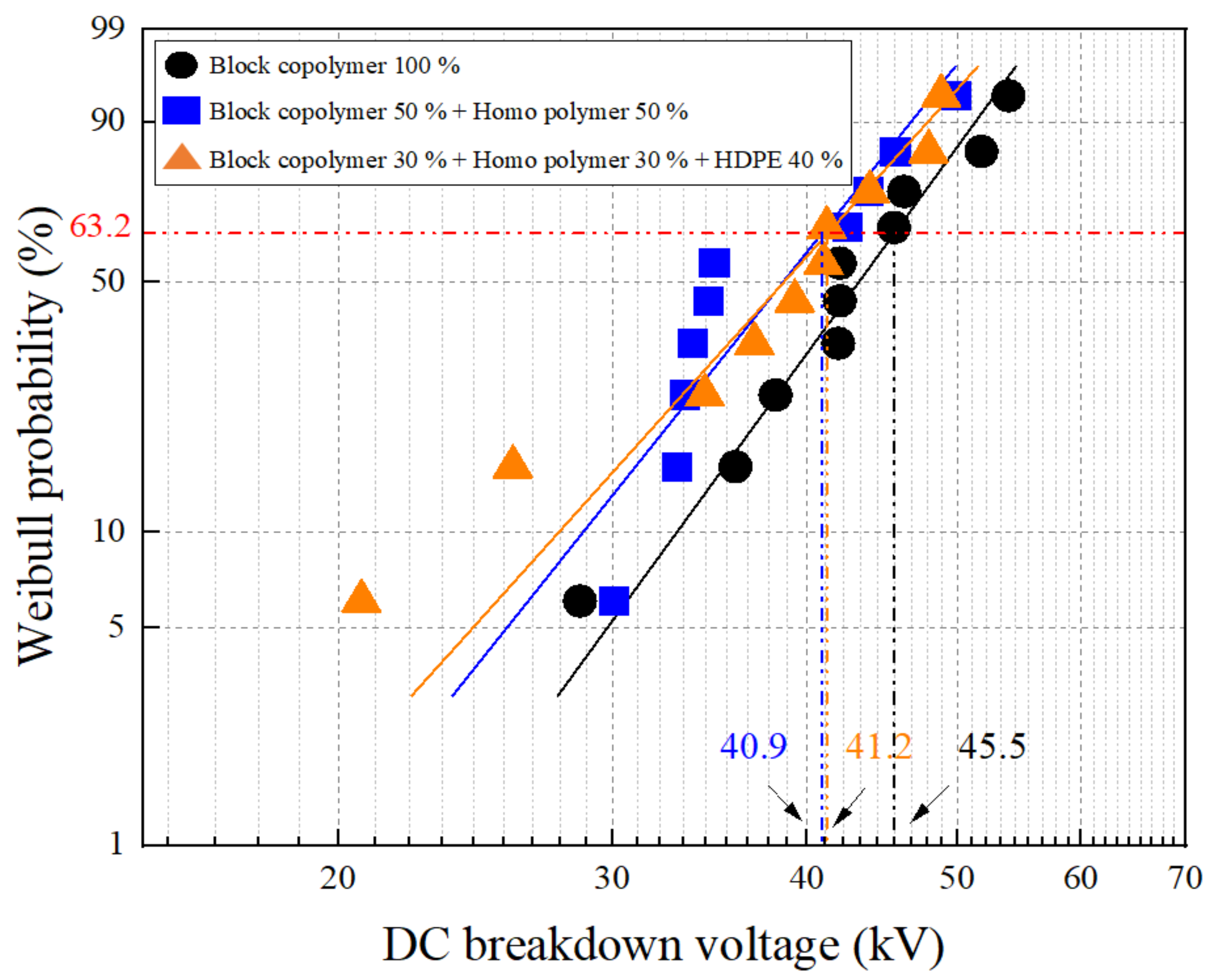

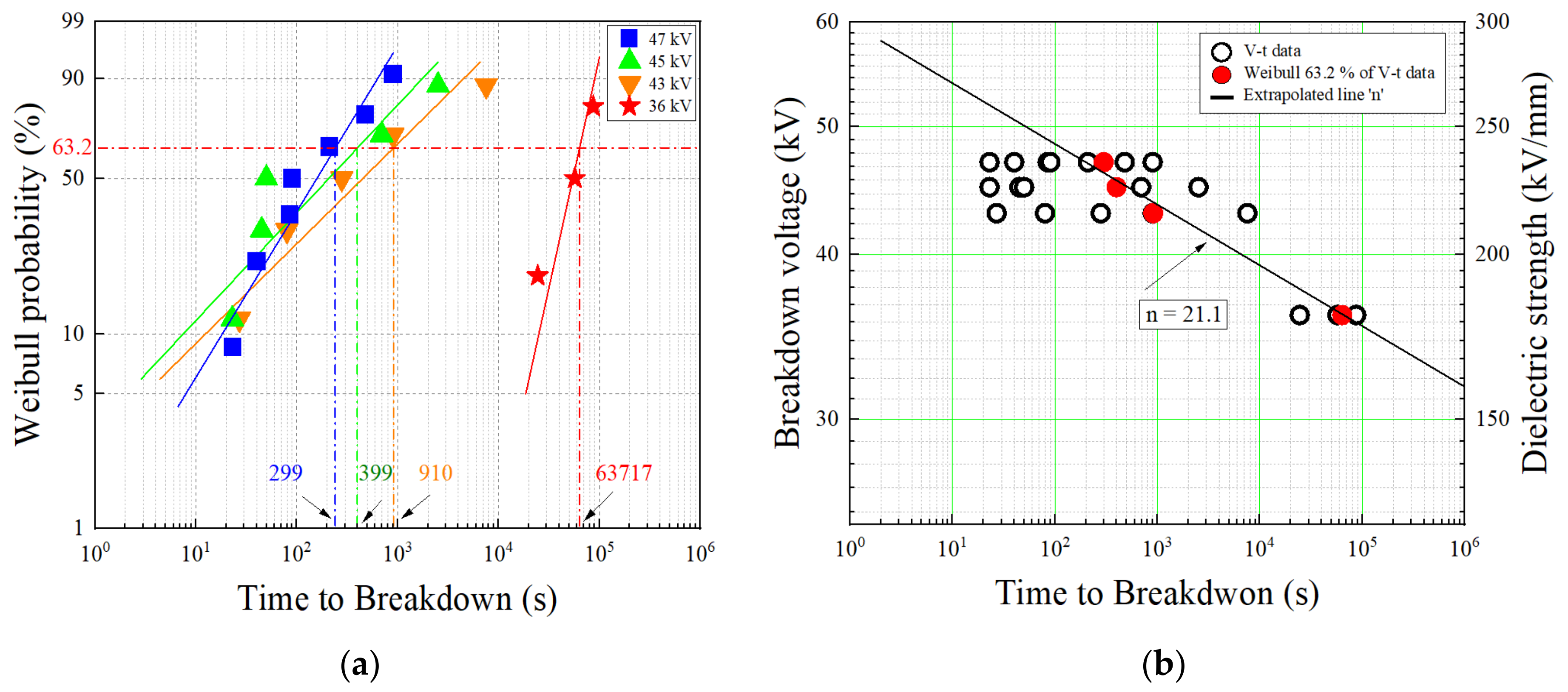
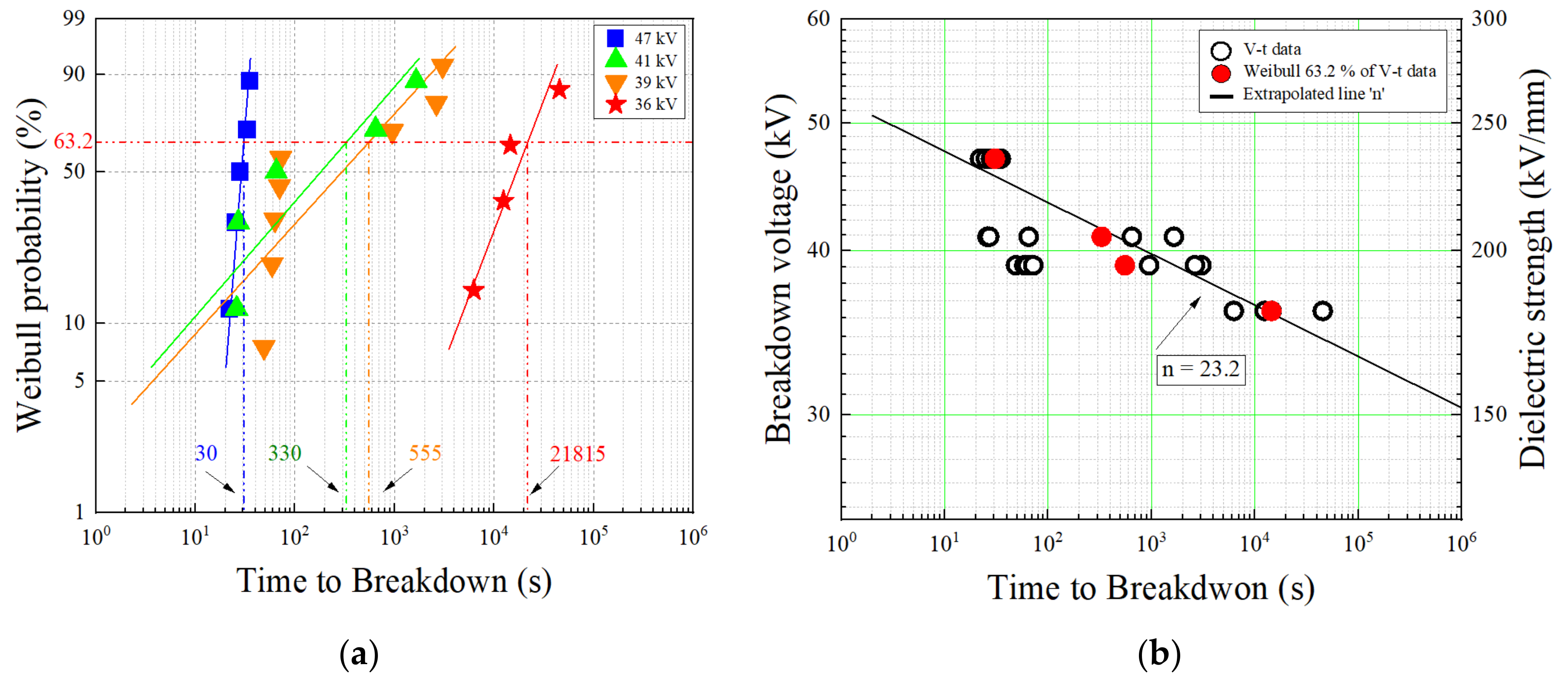
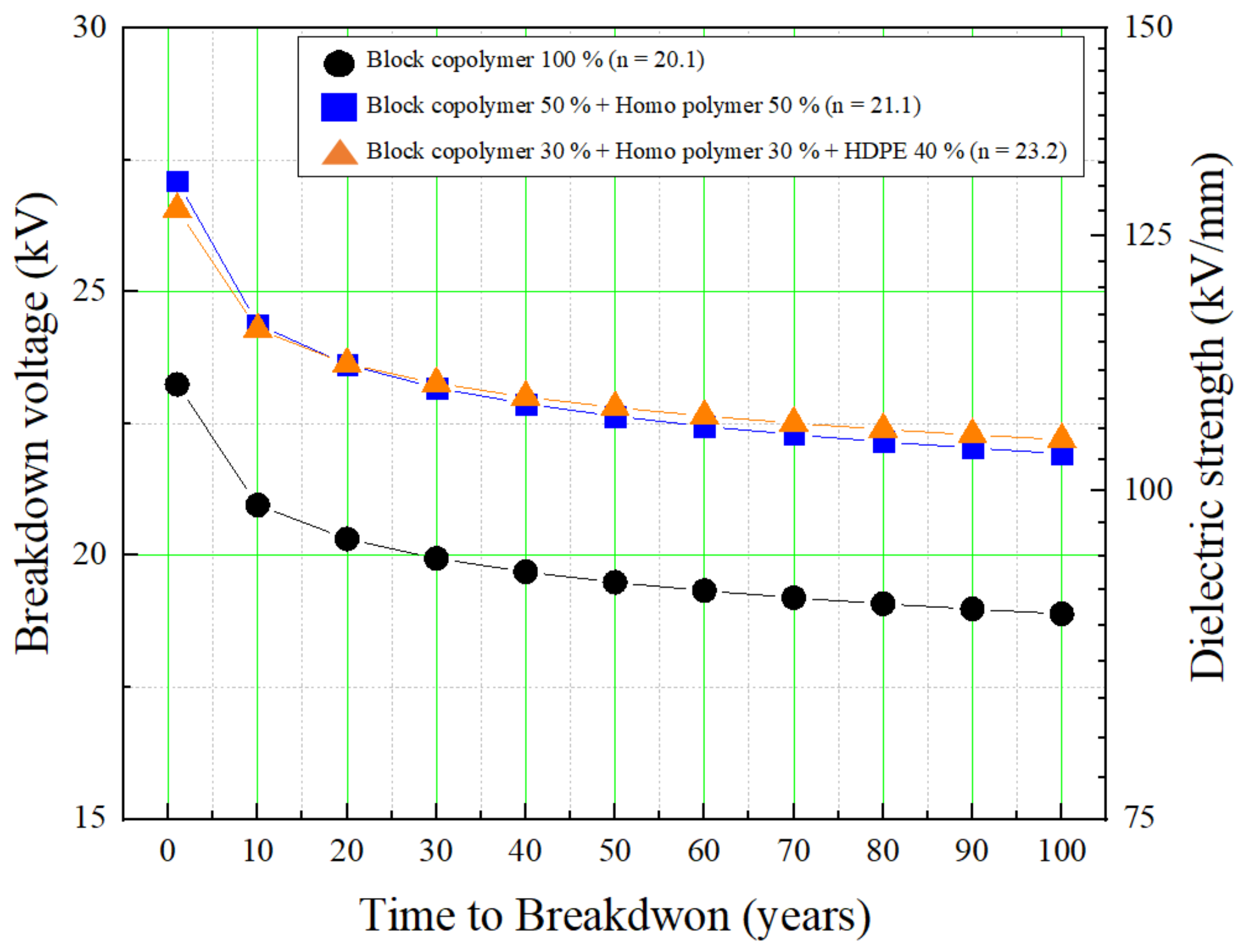
| Description of the Test Samples |
|---|
| Block copolymer = 100% |
| Block copolymer : Homo polymer = 50% : 50% |
| Block copolymer : Homo polymer : HDPE = 30% : 30% : 40% |
| Block Copolymer = 100% | Block Copolymer : Homo Polymer = 50% : 50% | Block Copolymer : Homo Polymer : HDPE = 30% : 30% : 40% | |
|---|---|---|---|
| Scale parameter | 45.5 | 40.9 | 41.2 |
| Shape parameter | 6.9 | 6.3 | 5.6 |
| Description of the Test Samples | Life Exponent | Life Estimation Formula |
|---|---|---|
| Block copolymer = 100% | 20.1 | |
| Block copolymer : Homo polymer = 50% : 50% | 21.1 | |
| Block copolymer : Homo polymer : HDPE = 30% : 30% : 40% | 23.2 |
| Description of the Test Samples | Breakdown Voltage | Performance |
|---|---|---|
| Block copolymer = 100 % | 19.6 kV | Benchmark |
| Block copolymer : Homo polymer = 50% : 50% | 22.8 kV | 16% |
| Block copolymer : Homo polymer : HDPE = 30% : 30% : 40% | 23 kV | 17% |
Publisher’s Note: MDPI stays neutral with regard to jurisdictional claims in published maps and institutional affiliations. |
© 2021 by the authors. Licensee MDPI, Basel, Switzerland. This article is an open access article distributed under the terms and conditions of the Creative Commons Attribution (CC BY) license (https://creativecommons.org/licenses/by/4.0/).
Share and Cite
Lee, S.-W.; Kim, H.-J.; Kwon, I.-S.; Lim, J.-S. Evaluation of Electrical Performance and Life Estimation of PPs for HVDC Power Cable. Energies 2021, 14, 5673. https://doi.org/10.3390/en14185673
Lee S-W, Kim H-J, Kwon I-S, Lim J-S. Evaluation of Electrical Performance and Life Estimation of PPs for HVDC Power Cable. Energies. 2021; 14(18):5673. https://doi.org/10.3390/en14185673
Chicago/Turabian StyleLee, Seung-Won, Hae-Jong Kim, Ik-Su Kwon, and Jang-Seob Lim. 2021. "Evaluation of Electrical Performance and Life Estimation of PPs for HVDC Power Cable" Energies 14, no. 18: 5673. https://doi.org/10.3390/en14185673






